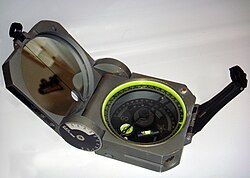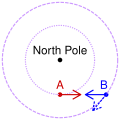Bearing (navigation)

In navigation, the word bearing is used for different methods that try to find out the angle between an object used for this purpose, and a reference direction. There are different systems of reference that can be used for this. A system of reference that is commonly used is that of Cardinal directions, as they can be found with a compass. The direction a ship is pointed can also be the reference.
Points that can easily be determined, and that move very little, can be taken as reference. Such points include stars, mountains, the sun, and beacons. Beacons come in the form of lighthouses on the coast, but also as electric beacons or other sea marks on the open sea.
Bearings can be measured different ways. Optical bearings rely on visual information, other systems rely on radar for tools.
A standard Brunton compass, used commonly by geologists and surveyors to obtain a bearing in the field
A compass rose, showing absolute bearings in degrees.
The bearing between Cape Town and Melbourne along the geodesic (the shortest route) changes from 141° to 42°. Azimuthal orthographic projection and Miller cylindrical projection.
A and B are near the North Pole and facing each other. Though A is facing east, B is not facing west. If B were to face west, her direction (dashed arrow) would be tangential to her latitude circle (dashed circle). Only on the equator is it true that if A faces east and B faces west that they can face each other.






